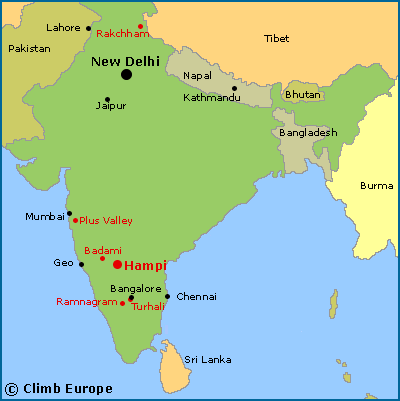Rock climbing in India
The Himalaya Mountains dominate northern India where there are many mountaineering opportunities. However in southern India there are many well developed rock climbing areas, in particular the world class bouldering venue at Hampi.
Bouldering at Hampi
Hampi has quickly become an internationally known world class bouldering destination that attracts climbers from all over the world. The sheer quantity and quality of the pristine granite boulders that are scattered around make Hampi the largest bouldering area in the world. Currently only a small amount of these boulders have been devolved providing great scope for establishing new problems.
Hampi is a UNESCO World Heritage Site due to the extensive ruins of the temples associated with the old Vijayanagar capital that are up to 800 years old. The main bouldering areas of Hampi Bazaar and Hampi Island are scattered amongst these impressive ruins, hence providing a unique climbing experience.
The Bouldering at Hampi has a great variety of styles. There is everything from slightly overhanging walls with positive and sometimes small crimps, great arêtes, to frustrating slopers, and impressive crack routes. Most of the boulders have good landings though a bouldering mat is advisable due to their height. In fact some of the boulders are definitely considered high-ball, and some are so high they would be classed as actual routes elsewhere. Fortunately it is possible to hire mats locally.


The above photographs are courtesy of Geo Quest who publishes the definitive guidebook for Hampi, called Golden Boulders, which can be bought from our shop.
Bouldering at Hampi – Climber's logistics
The best time of the year to boulder at Hampi is November and December, with January and February also good times to visit. Even so during these times the temperature is still hot, so the strategy is to start early at sunrise, take a long mid-day break during the heat of the day, and return again in the evening until sunset. March to June is really hot. Then the monsoon (rainy season) arrives, making the boulders wet and slippery. By August monsoon recedes but the heat still persists, though it starts to decline until being reasonable in November again.
The definitive guidebook for the area is called the Golden Boulders, which describes over 1,400 routes across a wide range of grades. Buy this guidebook from our shop.
Getting to Hampi is via the town of Hospet that is 14km away. The Indian train service is excellent and comfortable, and there are trains to Hospet from Bangalore, Hyderabad and Goa. From Hospet, it is best to hire an auto rickshaw to Hampi and the distance can be covered in 30 minutes.
With regards to gear, bring as many bouldering mats that you can travel with, though extra ones can be hired locally. It is also not unusual for visiting climbers to donate older mats to the locals at the end of a trip.
Other rock climbing areas in India
Map of the main rock climbing areas in India
